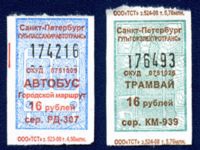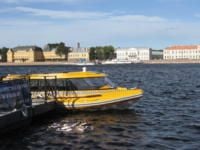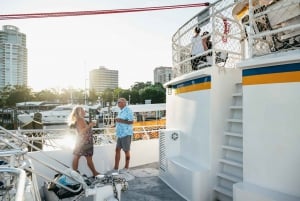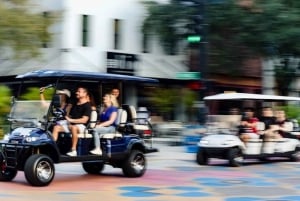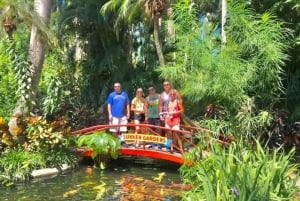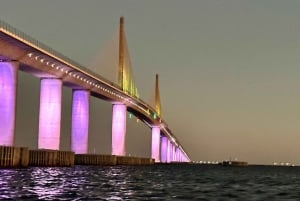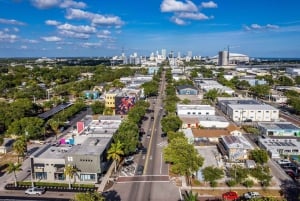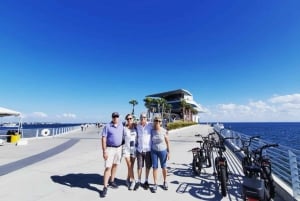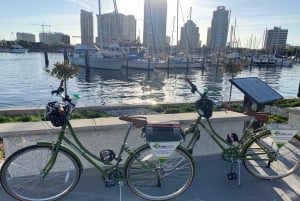Getting Around
Introduction
In the absence of private vehicles, the Soviet Union invested a lot of resources in developing an extensive public transport system across the country, and this legacy is visible in St Petersburg to this day. An underground metro, buses, trams, trolleybuses, and as befits a city built on and around the sea, water taxis, all ensure today's city of 5 million inhabitants can get around for work and pleasure with some ease. The last 20 years has also seen a boom in private transport. While the city's traffic is not as notorious as that of Moscow, the combination of a historic centre, bridges which open to allow ships through, the sheer volume of traffic on the roads, and laws which forbid moving vehicles after an accident (however small) means progress on the roads can at times be extremely frustrating and agonizingly slow. So where possible, walking between the sites in the city centre is by far the best way of getting around. If walking is not an option, then the following section provides information on the best options to get around the city.
Metro
Although there were plans afoot as far back as the 1890s to create an underground railway network for St Petersburg, the capital of the Russian empire, these did not develop much beyond talking and when Stalin first ordered the building of an underground system in the 1930s (known generically as the Metropolitan, or Metro for short), Moscow naturally took precedence as capital of the USSR. Construction on Leningrad's metro system began in April 1941, but with the German invasion just two months later all work ground to a halt until 1946. In November 1955, the first trains started running along the Avtovo - Ploschad Vosstaniya line. Today the system consists of 5 lines, a total of 64 stations, and approximately 112 km of track and is used by around 2.5 million people every day. The system is usually considered the deepest underground system in the world - it can take up to 5 minutes to descend by escalator to the platform - and in December 2011 the world's deepest station opened at Admiralteyskaya, 105 metres below the surface. Although overall the stations do not compare with the sheer scale and luxury of the Moscow metro, there are still plenty of wonderful stylistic, design and architectural features to look out for such as marble, granite, columns, sculptures, mosaics and stained glass. Many of the station designs and interiors match their name - in other words the Tekhnologicheskiy Institut (which means the Technology Institute) station is designed along the theme of Soviet science, Elektrosily reflects Communism's success in providing electricity throughout the country, and Kirovskiy zavod (Kirov Factory) has an industrial theme. On public holidays and other special days, the halls and escalators are filled with appropriate music played over the loud-seakers - rousing World War II choruses on Victory Day, or extracts from Swan Lake on Tchaikovsky Day.
There is a flat fee for a single ride anywhere on the network of RUB 28. You can purchase a zheton, or token, from the kassa (ticket office) of which there may be several at the entrance to the station or from a machine. There are various ticketing options you can also buy for multiple trips on the network (proezdniy bilet for e.g. 10 trips over 7 days, 20 trips over 15 days, etc) which reduce the cost per-trip, but be aware that you may need to present a passport and/or photo to purchase these. Another useful option for the traveller is a ediniy bilet, which is valid for a set period of 2 weeks or one calendar month and is valid on all forms of public transport within the city. Carrying heavy luggage attracts an additional small payment, although you may be able to avoid this. There are student and invalid discounts available so be sure to ask about these too. Further information on the network can be found at the official website. Getting around is relatively straightforward due to the limited size of the network, the colour coding of the various lines, and the dual language signs (Russian/English) on maps and platforms - you won't find that in Moscow! Click here for an interactive metro map.
Overground transport
Buses, trams and trolleybuses run from approximately 0545 to midnight. Routes are posted on the front and side and should also be on a board at the stop, but these are often only in Russian so it helps to have a rough idea where you are going. Tickets cost a flat fare of RUB 23 and can be purchased on board from the conductress (usually, although sometimes entrance at the front only will require that you buy your ticket from the driver). A ediniy bilet (see above) can also be used if you expect to do a lot of travelling round or will be staying in the city more than a couple of weeks. Riding 'like a hare' as the Russian expression has it (zaytsem, or without paying) will cost you a RUB 1000 fine if caught. Unlike in major cities in western Europe, it is still expected that younger and more able people will give up their seat to an elderly, disabled or pregnant passenger, or those with small children. Don't wait to be asked.
Trams were the earliest form of public ground transport, first installed in 1907 and worked continuously throughout the Blockade. Even though many tramlines have been discontinued in the last 20 years and their tracks removed, the city is also reported to have the largest tram network in the world with around 600km of track.
St Petersburg was the third city in the country (after Moscow and Kyiv, today in Ukraine) to install a trolleybus network, in 1936. A tram runs on rails, but a trolleybus has wheels and is powered by electricity from cables it is attached to. This helps explain all those wires you will see in the streets which get in the way of the 'perfect shot' of a church or other notable building!
Click here to access an interactive route planning tool.
Marshrutka
Another feature of post-Soviet public transport is the marshrutka, a private bus service that provides service sometime in competition with existing public transport options, but often too between points not served by public transport. They are usually mini-buses which depart when full, and indicated with an initial letter K before the number. Tickets are usually higher than public transport, so around RUB 30-40 per trip. They can be stopped for pick-up or drop-off anywhere along their route. Payment is usually made to the driver upon entry or exit, be aware that in some the person sitting in the middle seat at the front - i.e. closest to the driver - is expected to take responsibility for collecting the money from the other passengers - so avoid that seat if you don't want to be collecting money and handing out change! It's fair to say that although they are a sometimes indispensable part of the public transport system, marshrutka drivers have a reputation for fast and somewhat reckless driving, so be aware of this if you're a nervous passenger. Otherwise enjoy the insight into Russian urban culture, and hold on tight!
Taxis
There is a large number of taxi firms across the city which have clean and comfortable fleets, and where possible your best option is to call one of these in advance, speak to the dispatcher, agree the fee, and wait to be collected. In many cases your hotel or guest house will be able to arrange this for you. It is also possible to find taxis outside hotels, at a number of taxi ranks in the center (for example, by Gostinniy dvor), or to flag one down in the street. Not many run on the metre, and the minimum fare is likely to be RUB 300-400. Be prepared to bargain a little, as the fare quoted for foreign passengers will invariably be higher than it should be, and be aware that fares at night will be higher again, perhaps as much as two times higher. Taxi firm 777 (tel: + 7 812 777 1777) has an English-language site where you can book online and receive phone confirmation.
You may have heard stories of how you can stick out your arm and within a few seconds a private car will stop and take you anywhere you want for an agreed fee. Known in Russian as chastnik, or bombil, these are still quite common, although were more common in the days when there were fewer taxis. Nowadays the authorities are trying to clamp down on the practice, so be aware that you may attract unwelcome attention if you try to do it. If you do not speak Russian, there are also bound to be communication difficulties. Anyway if you have no other option, then stand on the kerb and stretch your arm out at 90 degrees and within a few seconds a rather battered car is likely to pull up and ask you where you want to go. There are of course potential safety risks attached to this, so never get into a car that looks to be in an un-road-worthy condition, or a car which contains other passengers, and be extra cautious as a single woman. What goes for the marshrutka drivers (bad driving, recklessness etc) goes double for most chastnik drivers. Having said all that, some of the most interesting conversations we've ever had have been with chastnik drivers, so exercise your judgement and you may end up with a convenient, cheap and interesting experience to recount back home!
Water buses
What vaporetto is to Venice, akvabus is to St Petersburg! It may not have quite the same ring to it, but the network of modern, 12 to 120-seater boats that zip and bounce around the rivers and canals according to pre-set routes is a great way to get from A to B and to see some of the city from the water. There are 5 routes which extend from Prospekt Rybatskoye in the south, to Staraya Derevnaya on Yelagin Island in the Outlying Islands to the north of the centre, and even go out to Kronstadt in the Gulf of Finland. During the navigable season (approximately April to November) the boats run every 15 minutes between 0800 and 2000. Stand on the jetty and make sure you're visible as the captain won't stop unless there are passengers getting on or off. Fares are a flat RUB 54 per trip sector, so if you're changing between lines you'll need to buy a new ticket on each boat. But it's a fun and efficient way to get around and see something of the city away from the main canals and tourist areas. Click here to access the Akvabus route map.
Car rental
Very few foreign visitors to the city rent a car. Even many long term, expatriate residents, will hire a driver to get them around. As we were writing this part of the guide, we tried to think of some reasons why car rental might be a good idea, and consulted a local, Russian-language guide book for their advice to Russian tourists. It wasn't surprising to find there a long list of reasons why renting a car to see the city is not recommended, even for Russian visitors, from the chaotic nature of the traffic, poor driving quality and road surfaces, long traffic jams, parking restrictions, narrow embankments, weather conditions, corrupt traffic police...the list goes on. Nevertheless if you do decide to rent a car to get out of the city, for example, and visit the outlying estates or get some fresh air along the Gulf of Finland, then there are several car rental firms operating in the city. These are plotted on the map below. Make sure you have plenty of insurance coverage to account for all eventualities. Another option is to rent a car and driver - see below.
Hertz
Nevsky prospekt, 85 (Moskovsky vokzal)
St Petersburg
tel: +7 812 326 4505
Also Pulkovo 1 and Pulkovo 2
42A Moskovskoe shosse
St Petersburg
tel: +7 812 385 5202
Nevsky prospekt 63, Office 43
St Petersburg
tel: +7 812 314 6024




